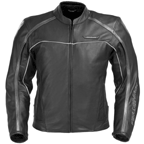|
Motorcycle Jackets: Leather and Textile Riding Jackets for All Riding StylesAfter your helmet, motorcycle jackets really are your next best line of defense in the world of motorcycling. But, flipping through motorcycle jacket reviews looking for the right one can be pretty frustrating. What’s the best one for you?
The quick answer is one that protects you in a crash and is comfortable to wear while you ride. And just like your helmet, if your jacket isn't comfortable you won't wear it. And it certainly can't save your bacon when it's hanging up in a closet! That means it needs to be able to keep you comfortably cool on hot Summer days and warm enough for those cool evening rides in Fall. It may be impossible to ask this from a single jacket, so let’s take a closer look at the ultimate motorcycle jacket and see if some real ones come close.
Abrasion ResistanceJust about everyone who's been a kid (that includes you, right?) has fallen off their bicycle and gotten some road rash. With me, I usually ended up with some gravel embedded in my palms from trying to break my fall, not to mention a badly bruised and separated shoulder from a more recent trip over the handlebars. My brother had a horrific crash on a bicycle at probably 25-30 mph, which left him badly scraped up and with permanent reminders of that day. If he was on a motorcycle at highway speeds (and more than 8 years old), it would have been even worse. So, I've had an easy decision about protecting myself from road rash as much as practical.
The old trusty leather motorcycle jacket gives some of the best abrasion protection you can buy. However, as more modern materials come into the market, there are more choices if you opt for a textile motorcycle jacket . Materials such as Cordura(TM) (nylon) and Kevlar offer good protection in this area as well. The possible advantage of leather (and probably the reason why professional motorcycle road racers continue to use it) is that it is a low-friction material. This means when you hit the deck, leather will tend to slide instead of gripping the road surface. And if it grips the road, it'll send you tumbling, which tends to bust up your elbows and hands as you roll to a stop. Denim is reasonably abrasion resistant, but it won't last long in a motorcycle crash. It's better than nothing and is my personal bare minimum for riding, and even then I'm talking about wearing jeans on a ride instead of my leather motorcycle pants,not my jacket. I always wear my leather riding jacket. Impact ProtectionThe ultimate motorcycle jacket also needs to provide impact protection in important areas such as the elbows, shoulders and back. Well-placed armor can help soak up the impact of a fall in these areas. The armor can be sewn directly into the jacket or is sometimes removable by using Velcro strips to hold the armor in place. There are a couple main types of armor used in good quality motorcycle jackets: foam and hard plastic "race" armor. Foam armor is usually made from closed-cell foam, which is a pretty dense material. (A lot more dense than your the open-cell foam rubber cushions, one of which is probably caressing your rear right now.) The armor cushions your body against the jarring impact of a fall (the sudden stop is what hurts, right?). It also needs to spread the impact over as large an area as possible, which lessens the force of the blow. A closed-cell foam doesn't feel all that spongy, but it does increase the distance and time over which a blow is delivered, which is good for your fragile self. The foam is rigid enough that when it deforms, it disperses the impact over an area larger than just the point of impact. More area equals less ouch! Race armor is harder so it can protect a rider in a harsher, higher speed crash and will spread the force of impact over a larger area than a foam pad will. This usually comes at the expense of comfort, since the hard plastic shell of the race armor is obviously less flexible. This type of armor is made from semi-hard plastic and may have a closed-cell foam backing to add a bit of comfort. Although not nearly as flexible as foam armor, it's designed to protect better in a crash. For example, say you low-side your bike in some oil as you go into a turn and your elbow hits the ground hard. The race-style armor forms a cup around your elbow and extends partway down your forearm, so when the tip of your elbow hits the tarmac, instead of smashing and grinding it down (ouch!) the armor spreads the impact over your entire elbow joint and down your forearm. In that crash with race armor, maybe you'd get a bruised elbow and walk away a bit rattled and mostly worried about your bike's health. If you were wearing a good motorcycle jacket with soft armor, maybe you have a painful contusion that needs a few weeks to heal. If you're one of those people who go out for a ride with a pair of Oakley sunglasses, t-shirt, shorts and flip-flops, you'd probably have a chipped or broken elbow that's been ground down a bit. Not to mention similar things with your legs, hip, back, sides and whatever other parts you want to talk about. No thanks.
Return from Motorcycle Jackets to Everything Motorcycle Home Page |

